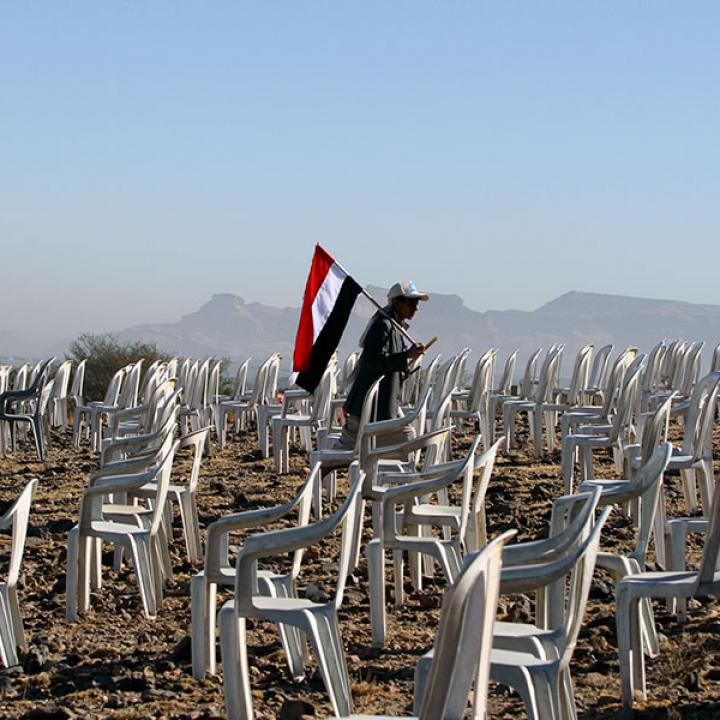

An expert on the Gulf country, joined by a former U.S. ambassador, discusses her groundbreaking interactive guide to the players and dynamics underlying its conflict.
On October 7, 2020, The Washington Institute held a virtual Policy Forum with Elana DeLozier and Ambassador Stephen Seche to debut Yemen Matrix: Allies & Adversaries, a resource guide and interactive online tool that focuses on the grievances driving events in modern Yemen. Elana DeLozier, the project’s creator, is the Institute’s Rubin Family Fellow and an adjunct assistant professor at Georgetown University’s Center for Security Studies. Stephen Seche is executive vice president of the Arab Gulf States Institute in Washington and former U.S. ambassador to Yemen. The following is a rapporteur’s summary of their remarks.
Elana DeLozier
The idea for the Yemen Matrix project was born out of a desire to help people get up to speed on the complexity of the current situation in Yemen. In creating this project, I wanted to give a sense of the major relationships and events shaping the war in Yemen while focusing on the complex web of stories that have shaped it. To explain the conflict, this project uses a storyline approach, a method that attempts to humanize the story of Yemen by explaining history through the people and groups that have experienced it.
The Yemen Matrix focuses on three types of information: actors, events, and relationships. The project looks specifically at twelve major actors. Although limits on the size of the project preclude an entirely comprehensive list of actors, it does focus on the major individuals and groups that are influential or worth watching today. Still, as the project’s introduction notes, prominent omissions include tribes, splinter factions within the main political parties, and terrorist groups. The project also omits foreign powers such as Qatar, whose relations to other actors are more difficult to pin down but will merit inclusion if their influence continues to grow.
The select events are key historical occurrences shaping the perspectives of Yemenis living today. Focusing on these events allows for a deeper understanding of the current political dynamics in Yemen. For Yemenis, past events continue to influence present ones, and the events of 1962, 1986, 1994, and 2004 are still as much in play as are events of today.
Finally, the project covers five main types of relationships, which fall on a spectrum from allies to adversaries, with favorable, complicated, and unfavorable between these poles. The project takes the approach that relationships are not stagnant and will move along the spectrum. The matrix also attempts to be as timeless as possible and will be updated in response to any substantial relationship changes.
One key takeaway from this project is how firmly grievances remain at the heart of decisions and relationships in the present—and how this will continue in the future. Thus, if one is trying to understand why an alliance exists in Yemen, it is often best to start with shared grievances. An example is the Houthi invasion of the south in 2015. For the government of Yemeni president Abdu Rabu Mansour Hadi, the Houthi takeover of Aden was yet another symbol of the Houthi coup against it. For the Southern Transitional Council (STC), this event marked another chapter of northern invasion of the south. This shared sense of injustice aligned the Hadi government and the STC temporarily against the Houthis, yet their own enmity for each other—rooted in events in 1986, 1994, and afterward—simmered underneath and eventually emerged violently.
Another conclusion that can be drawn from the matrix is that Yemen’s closest alliances are primarily with foreign actors. Almost all major Yemeni actors rely on an outside patron for financial support—as the STC does with the United Arab Emirates, the al-Mahra protestors do with Oman, and the Houthis do with Iran. Despite such patronage, most Yemeni groups express sentiments that are fiercely against foreign interventionists. Thus, Yemen’s relationships with foreign patrons are multidimensional: the financial resources aid Yemeni groups’ pursuit of their ambitions, but these groups guard their autonomy by not always following their patrons’ advice. It is rare for a group in Yemen to act as a full proxy for an outside country; indeed, Hadi occasionally snubs Saudi Arabia, the Houthis have flouted Iranian advice, and the STC sometimes defies the UAE’s cautions. This multidimensionality is important for policymakers to keep in mind because people tend to oversimplify their explanations for the dynamics in Yemen.
Stephen Seche
The Yemen Matrix will quickly establish itself as a crucial research tool for all Yemen watchers. The project takes on the difficult task of explaining (1) the unique dynamics of the conflict in Yemen and (2) how those dynamics have evolved. In doing this, the project offers vital details on the factors at play in Yemen while also acknowledging the fluidity of the situation and how quickly relationships can change.
One glaring conclusion that can be made from this matrix is that women are absent from positions of power and influence in Yemen. Despite the efforts of UN special envoy Martin Griffiths to include the voices of Yemeni women, much remains to be done to ensure that women are involved in decisionmaking processes. The matrix also sheds light on the competing personal interests among key decisionmakers in Yemen, many of whom believe that what benefits them personally will also benefit the country at large. Such views have thus elevated personal interests over national well-being.
This summary was prepared by Zied Bouchlaghem. The Policy Forum series is made possible through the generosity of the Florence and Robert Kaufman Family.




